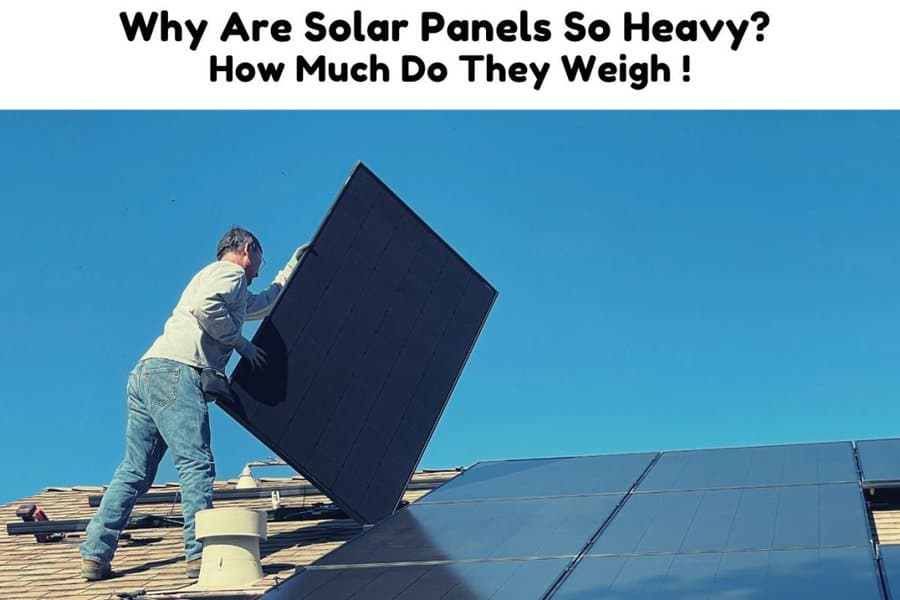Silicon is the main ingredient in a solar panel. Used to make everything from bricks to ceramics, silicon is a relatively light material. It’s so light it weighs less than the calcium in your bones.
If silicon is so light, what makes up the weight in a solar panel? Most of the weight in a solar panel comes from the other materials that are used to house and protect the delicate silicon inside it.
In this article, we explore what goes into a solar panel and whether a solar panel can be too heavy for your roof.

Are Solar Panels Very Heavy?
Solar panels are not heavy. While the weight of solar panels can vary, an average sized man can lift a large 72 cell solar panel without assistance. Portable solar panels are among the lightest and are designed for easier lifting. Rigid solar panels used for home solar system installations are typically heavier.
On a side note! If you’re in need of a reliable and high-performance portable solar panel, We strongly recommend the Jackery SolarSaga 100W Portable Solar Panel (Amazon Link).
With a high conversion efficiency and foldable design, this solar panel is easy to transport and set up, making it perfect for outdoor activities like camping, hiking, and RV trips.

The US solar cell technology used in this panel ensures that you get the most efficient and reliable solar charging possible.
There is also a 60W option that is more affordable (Amazon Link)
Generally, the bigger the solar panel, the more it will weigh. Source
How Much Does Each Solar Panel Weigh?
A solar panel has an average weight of about 40 pounds. The most a solar panel will weigh is about 50 pounds. This is for large 72-cell solar panels. These are the solar panels typically used in large scale installations. Residential installations mostly use smaller 60-cell solar panels that weigh between 35 to 45 pounds.
What’s in a solar panel?
The weight of a solar panel is made up mostly by its supporting and protective materials. A solar panel consists of:
- Solar cells that absorb sunlight and convert it into electricity. Solar cells are made from semiconductive material. The most common semiconductor used to make solar cells is silicon. There are other semiconductors like thin film but these constitute only 10% of solar panels.
- Glass cover that protects the solar cells from damage and moisture. A 6-7-millimetre-thick sheet of tempered glass six times stronger than ordinary glass protects the silicon solar cells. Without the glass cover the solar cells would get wet or would get damaged by the impact of objects like tree branches or hail stones. Some solar panels use a plastic cover.
- Aluminum frame that holds the construction together. Other metals are sometimes used, but aluminum is by far the most commonly used since it’s cheaper and lighter.
These are the major parts of a solar panel, with the glass making up the most weight and volume. Between 75-90% of a solar panel’s weight is in the glass. Only 5% of a solar panel is made up by the silicon cells that actually produce the energy.
| Material | COMPOSITION |
|---|---|
| Glass | 75-90% |
| Plastic | 4-10% |
| Aluminum | 6-8% |
| Silicon | 5% |
| Metal | 1% |
The weight we’ve given above is for rigid solar panels typically used for rooftop installations. But what about the flexible solar panels used for RVs and campervans? Are they as heavy?
How Much Do Flexible Solar Panels Weigh?
Flexible solar panels are thinner and lighter than conventional rigid solar panels. At an average of about 5 pounds, flexible solar panels weigh 8 times less than rigid solar panels which have an average weight of around 40 pounds.
The lightweight design of flexible solar panels is what makes them an attractive option for recreational vehicles, portable use and small applications. Flexible solar panels are made with thinner slices of silicon which makes them bendable.
Instead of sandwiching the cells between layers of glass, flexible solar panels use plastic instead. Using plastic is what makes them lighter than rigid solar panels as the glass is what makes up most of the weight in a panel.
Are Solar Panels Too Heavy For My Roof?
A roof can support up to 27 pounds per square foot. Solar panels add between 4 to 4.5 pounds of weight to a roof. A roof can easily carry the added weight of solar panels.
A standard roof can bear a weight of up to 300 pounds. The average solar system uses between 20 to 25 solar panels. At a maximum of 5 pounds each, a 25-panel system will only add 125 pounds of weight to a roof. That is 175 pounds shy of the maximum weight a roof can carry.
The weight a roof can carry is affected by the type and condition of the roof. Metal roofs can carry more weight at 27 pounds per square foot. Asphalt single roofs can hold a maximum of 20 pounds per square foot.
A newer roof is also able to handle more weight than an older roof. An older roof is likely to have expanded due to moisture absorption and will itself weigh more so will have less capacity to carry added weight.
Also, a sloped roof can handle more weight than a flat roof. Sloped or pitched roofs have a higher load-bearing tolerance because the weight is better distributed since it is not pressing directly down as with a flat roof.
Do you need to add extra support for roof solar panels?
Extra support can be added to the trusses or rafters of a roof but in most cases, this is not necessary. A roof should be able to support the weight of solar panels without any additional bracing.
Most solar contractors will inspect your roof for damage or aging prior to installing solar panels. A roof that needs extra support is highly likely a roof that needs to be replaced.
Why Are Solar Panels So Big?
The largest solar panels are about 6.6 by 3.25 feet. These solar panels have 72 solar cells in them which allow them to produce more energy in limited space. 60 cell solar panels are slightly smaller at 5.5 by 3.25 feet. Bigger solar panels will yield more energy per square foot.
The sun produces approximately 1,370 watts of energy per square meter. Solar panels are sun collectors almost like how a bucket can be used as a rain collector. A square meter of solar panel will allow you to collect more sun and thus produce more energy. Source
If you can have a larger surface area collecting sunlight, that then means there is more available energy for you to tap into
Also, solar panels are not 100% efficient at converting light into energy. They convert only up to 25% of light into energy. If they were more efficient, they could produce more energy from a smaller surface area.
